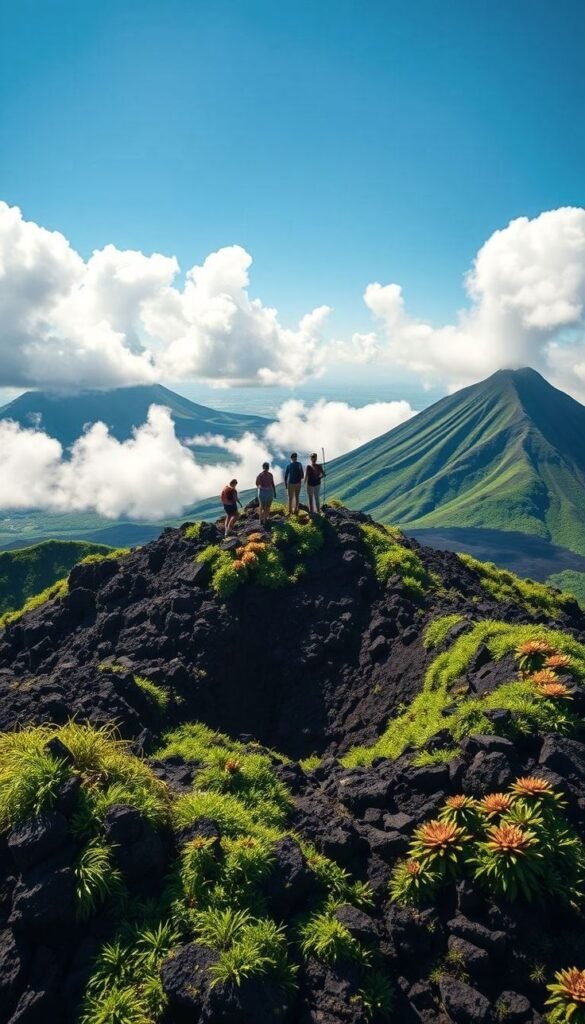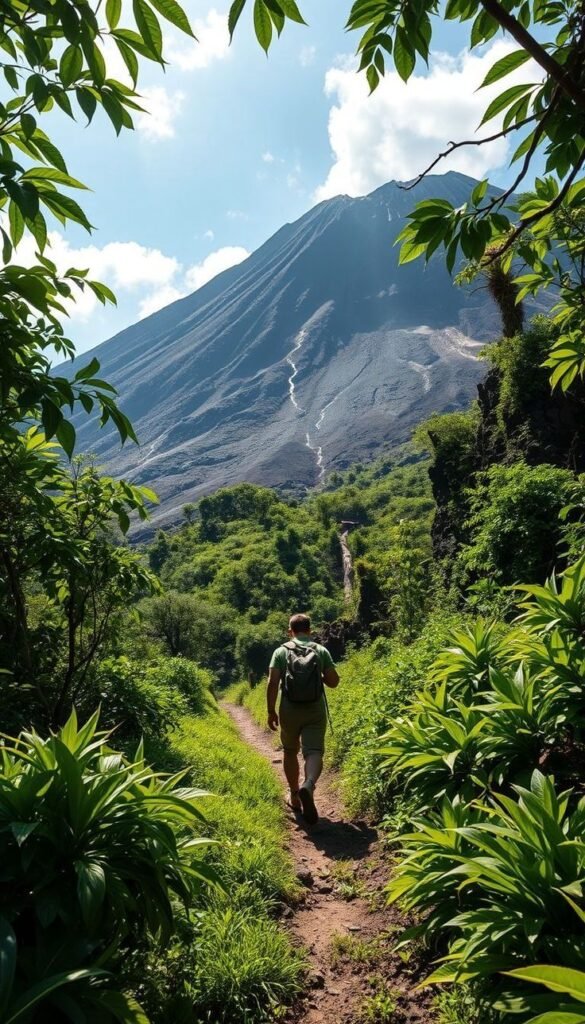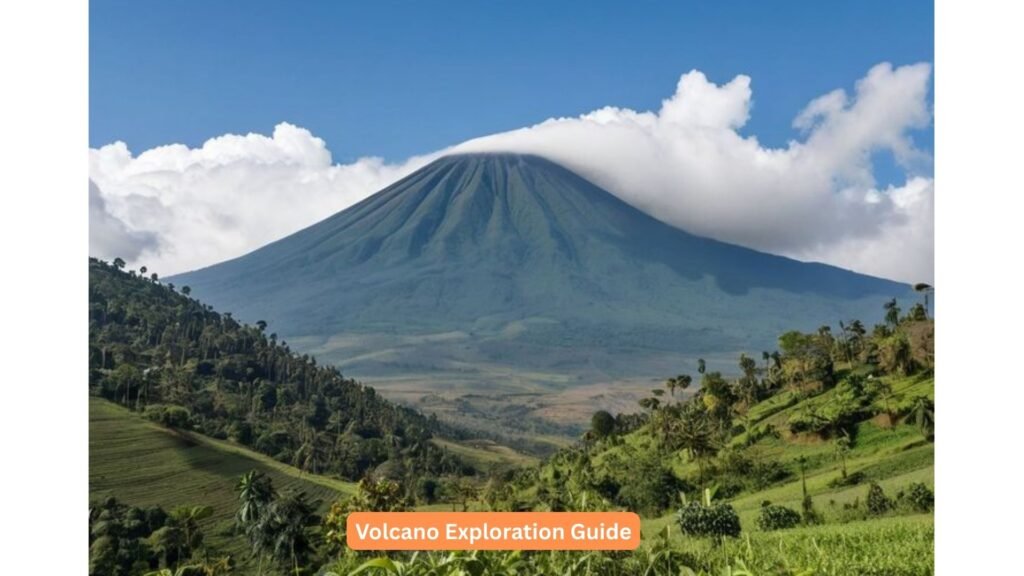Standing at the edge of a volcanic crater, feeling the earth rumble beneath your feet while wisps of sulfurous steam rise around you, creates an unparalleled connection to our planet’s raw power. Volcanoes—these magnificent geological features—represent Earth’s most dramatic expressions of internal energy, offering adventurers unique landscapes that continuously transform before our eyes. This comprehensive Volcano Exploration Guide will take you on a journey to the world’s most spectacular volcanic destinations, combining scientific insight with practical travel advice for the ultimate volcanic adventure. Whether you’re a seasoned volcano explorer or planning your first volcanic expedition, this Volcano Exploration Guide provides essential information to experience these geological wonders safely and memorably.
- Earth’s geological time machines: Volcanoes provide a rare glimpse into our planet’s internal workings, with each eruption bringing to the surface materials formed deep within the Earth over thousands or even millions of years, offering scientists invaluable research opportunities and travelers a chance to witness geology in action.
- Biodiversity hotspots: Despite their destructive potential, volcanic regions often host unique ecosystems with specialized flora and fauna that have adapted to thrive in mineral-rich soils and challenging conditions, creating vibrant pockets of life that demonstrate nature’s remarkable resilience and adaptability.
- Cultural significance: Throughout human history, volcanoes have shaped not only landscapes but also civilizations, with many cultures developing rich mythologies, religious practices, and artistic traditions centered around these powerful natural phenomena, leaving behind archaeological treasures and living cultural practices that connect past to present.
- Adventure tourism catalyst: The growing field of volcano tourism combines educational elements with adrenaline-inducing experiences, allowing visitors to hike across otherworldly landscapes, witness spectacular lava displays, bathe in geothermal waters, and gain a deeper appreciation for Earth’s dynamic nature while supporting local economies.
Understanding Volcano Types: A Traveler’s Guide to Volcanic Classifications
Before embarking on your volcanic adventure, understanding the different types of volcanoes will enhance your appreciation of these geological marvels and help you choose destinations that match your interests and comfort level. Within any comprehensive Volcano Exploration Guide, this knowledge is fundamental. Volcanologists classify volcanoes based on their shape, size, eruption style, and composition, with each type offering distinctive landscapes and experiences for explorers.
- Shield volcanoes: These broad, gently sloping formations—like Hawaii’s Mauna Loa and Kilauea—feature fluid lava flows that create smooth, dome-shaped mountains extending over vast areas, offering relatively accessible hiking opportunities across expansive volcanic fields and the possibility to witness active lava flows from safe observation points.
- Stratovolcanoes (composite volcanoes): The classic cone-shaped mountains that dominate volcanic skylines—such as Japan’s Mount Fuji, Italy’s Mount Vesuvius, and Indonesia’s Mount Merapi—are characterized by steep slopes formed through alternating layers of lava, ash, and volcanic debris, providing challenging hiking routes with spectacular panoramic views that reward those willing to make the climb.
- Cinder cones: These relatively small, steep-sided volcanic hills—like Mexico’s Paricutín and Italy’s Monte Nuovo—form from ejected lava fragments that cool before hitting the ground and pile up around the vent, creating accessible exploration opportunities for beginners and families interested in volcanic landscapes without committing to challenging terrain.
- Caldera volcanoes: These massive crater-like depressions—such as Yellowstone in the USA, Lake Toba in Indonesia, and Santorini in Greece—form when a volcano’s magma chamber empties and collapses, often creating lakes, thermal areas, and complex ecosystems that offer unique opportunities to witness the aftermath of nature’s most violent volcanic events.
Best Seasons for Volcano Exploration: Timing Your Adventure
Choosing the right time to visit volcanic destinations can significantly impact your experience, from visibility conditions and weather challenges to seasonal crowd fluctuations and unique volcanic phenomena that occur during specific times of year. Consider these seasonal factors when planning your volcano exploration adventure.
- Summer advantages (June-August in Northern Hemisphere): The warmer months typically offer clearer visibility at high-altitude volcanoes like Mount Etna in Sicily or Mount Fuji in Japan, with extended daylight hours allowing for longer exploration periods, though popular sites may experience higher visitor numbers and require advance booking for guided tours and accommodation.
- Winter exploration benefits (December-February in Northern Hemisphere): The contrast of snow-capped volcanoes against steam vents and thermal features creates spectacular photography opportunities at locations like Iceland’s volcanoes or Japan’s northern volcanic regions, while reduced visitor numbers provide more solitary experiences for those willing to brave colder conditions and prepare for winter hiking challenges.
- Shoulder seasons (spring/fall): These transitional months often provide the ideal balance of good weather, reduced crowds, and lower prices at major volcanic destinations worldwide, with April-May and September-October offering particularly favorable conditions for exploring Mediterranean volcanoes, Central American volcanic chains, and many Pacific Rim locations.
- Monitoring volcanic activity cycles: Some volcanoes display relatively predictable activity patterns that savvy travelers can research before planning their trips, such as Stromboli’s regular “Strombolian” eruptions that offer nighttime spectacles visible from safe vantage points, though always remembering that volcanic activity ultimately follows nature’s unpredictable schedule.
World’s Most Fascinating Volcanoes: Destinations for Your Bucket List
Our planet boasts hundreds of accessible volcanoes, but certain destinations stand out for their exceptional beauty, scientific significance, or unique visitor experiences. These volcanic wonders represent the diverse manifestations of Earth’s internal processes and offer unforgettable adventures for volcano enthusiasts.
- Mount Etna, Sicily, Italy: Europe’s tallest and most active volcano offers year-round exploration opportunities with well-developed infrastructure including cable cars, guided tours, and nearby accommodations, allowing visitors to witness frequent strombolian eruptions, explore recent lava flows, and enjoy the contrast between barren volcanic landscapes and lush Mediterranean vegetation on its lower slopes.
- Kilauea, Hawaii, USA: This shield volcano in Hawaii Volcanoes National Park provides accessible viewing of active lava flows (when erupting), well-maintained hiking trails through lava tubes and across solidified lava fields, and educational programs that explain the cultural significance of volcanoes in Hawaiian mythology and the scientific importance of this continuously monitored volcanic system.
- Mount Fuji, Japan: Japan’s iconic stratovolcano combines cultural significance with natural beauty, offering summer climbing opportunities along several established routes to its 3,776-meter summit, spectacular photography locations around its perfectly symmetrical cone, and nearby onsen (hot springs) where visitors can relax after their volcanic adventures while experiencing Japanese bathing traditions.
- Pacaya, Guatemala: This consistently active volcano near Antigua provides accessible day trips with local guides who lead visitors across dramatic volcanic landscapes to areas where you can roast marshmallows over natural heat vents, witness glowing lava (during active periods), and enjoy panoramic views of Guatemala’s volcanic chain from its slopes.
- Mount Bromo, Indonesia: Located within the spectacular Tengger caldera in East Java, this active volcano creates one of sunrise photography’s most iconic scenes when viewed from nearby vantage points, offers horseback riding opportunities across the misty “Sea of Sand” caldera floor, and provides insight into the volcanic traditions of the local Tenggerese people who still perform annual ceremonies at the crater.
Thrilling Volcano Experiences: Activities Beyond Basic Hiking
Volcanic regions offer diverse activities beyond simply hiking to the crater, with specialized experiences that cater to different interests, physical abilities, and adventure thresholds. A thorough Volcano Exploration Guide must include these alternative experiences that create unforgettable memories connecting travelers to the Earth’s dynamic processes.
- Volcano boarding: This adrenaline-pumping activity—pioneered at Nicaragua’s Cerro Negro volcano—involves hiking up the volcanic cone and then sliding down its steep, ash-covered slopes on specially designed wooden sleds or metal boards, reaching speeds up to 60 km/h while surrounded by volcanic landscapes and carrying bragging rights few adventure travelers can claim.
- Geothermal spa experiences: Volcanic regions around the world offer therapeutic bathing opportunities in naturally heated waters, from Iceland’s famous Blue Lagoon near Reykjavik to Japan’s traditional onsen in volcanic regions, New Zealand’s mud pools in Rotorua, and Italy’s ancient thermal baths near Mount Vesuvius, providing relaxing counterpoints to more strenuous volcano exploration activities.
- Lava tube caving: Explore these natural tunnels formed when the outer layer of flowing lava cools while hot lava continues flowing beneath, creating hollow passages that can stretch for kilometers, with notable examples including Hawaii’s Thurston Lava Tube, Iceland’s Raufarhólshellir, and the Canary Islands’ Cueva del Viento, offering opportunities to witness unique geological formations and specialized cave ecosystems.
- Volcanic wine tasting: Vineyards planted in volcanic soils produce distinctive wines with unique mineral characteristics, allowing oenophiles to combine volcanic exploration with wine appreciation in regions like Italy’s Mount Etna, Greece’s Santorini, Oregon’s Willamette Valley, and Chile’s volcanic wine country, where guided tours often explain the relationship between volcanic terroir and wine flavor profiles.

Essential Safety Precautions: Exploring Volcanoes Responsibly
While volcanic regions offer incredible experiences, they also present unique hazards that require proper preparation and respect. No Volcano Exploration Guide would be complete without addressing safety concerns. Understanding and following these safety guidelines will help ensure your volcano adventure remains a positive experience while minimizing risks to yourself and others.
- Research before visiting: Before planning any volcano trip, thoroughly investigate the current activity status through official geological survey websites, volcanic observatories, and recent scientific reports, paying particular attention to alert levels, restricted areas, and recommended safety protocols specific to your destination volcano.
- Hiring qualified guides: Local guides with volcanic experience provide invaluable knowledge about safe viewing areas, emergency procedures, and recent activity patterns, while supporting local economies and ensuring you don’t miss hidden features or important cultural contexts that enhance your understanding of the volcanic landscape you’re exploring.
- Respiratory protection: Carry proper masks (N95 or volcanic ash-rated) whenever exploring active volcanic areas, as volcanic gases like sulfur dioxide can cause respiratory distress, while ash particles are extremely fine and potentially damaging to lung tissue, with conditions changing rapidly depending on wind direction and volcanic activity levels.
- Emergency preparedness: Develop a clear communication plan with your traveling companions before entering volcanic areas, carry first aid supplies appropriate for burns and respiratory issues, maintain awareness of evacuation routes, and ensure someone outside your group knows your planned itinerary and expected return time, particularly when exploring remote volcanic regions.
Volcano Explorer’s Essential Gear: Packing for Geological Adventures
Proper equipment significantly enhances both safety and enjoyment when exploring volcanic environments, which often combine challenging terrain with unpredictable weather and unique hazards. This specialized packing list will prepare you for successful volcano exploration anywhere in the world.
- Footwear considerations: Invest in high-quality hiking boots with ankle support and heat-resistant soles designed for volcanic terrain, as conventional hiking boots can melt when crossing recently cooled lava fields or standing near thermal features, with vibram rubber soles offering the best combination of heat resistance, traction on loose volcanic materials, and comfort during long hikes.
- Layered clothing strategy: Volcanic environments often experience extreme temperature fluctuations between exposed ridges and sheltered valleys, while higher elevations can be significantly colder than base areas, requiring a flexible clothing system with moisture-wicking base layers, insulating mid-layers, and windproof/waterproof outer shells that allow adaptation to rapidly changing conditions.
- Specialized protective equipment: Depending on your destination’s activity level, consider carrying items such as a proper respirator mask (N95 minimum) for ash and gas protection, heat-resistant gloves for handling volcanic materials, eye protection against ash and sun glare, and a helmet when exploring areas with potential for falling rocks or visiting active eruption zones with qualified guides.
- Technology and navigation tools: Pack a GPS device with offline maps of your volcano destination, a compass for backup navigation, a reliable headlamp with extra batteries for unexpected darkness or lava tube exploration, and heat-resistant containers for safely collecting (where legally permitted) cooled volcanic samples that won’t melt through regular plastic bags.
Volcanic Phenomena: Witnessing Earth’s Spectacular Displays
Volcanoes create some of nature’s most impressive visual displays and unusual natural phenomena, ranging from dramatic explosive events to subtle, complex processes that transform landscapes over time. Understanding these phenomena enhances the volcano explorer’s experience and appreciation of these dynamic environments.
- Lava flow observation: Witnessing molten rock flow across the landscape represents one of nature’s most mesmerizing displays, with pahoehoe lava creating smooth, ropey textures as it advances slowly enough to observe safely (with proper guidance), while faster-moving a’a lava forms jagged, clinker fields that demonstrate the raw, destructive power contained within our planet.
- Fumaroles and steam vents: These openings in the Earth’s crust release superheated steam and volcanic gases, creating otherworldly landscapes of billowing vapor plumes that shimmer against the sky, deposit colorful mineral formations, and provide habitats for extremophile organisms that have adapted to survive in these hostile conditions.
- Volcanic lightning: During explosive eruptions, the friction between ash particles can generate spectacular electrical discharges within the eruption column, creating what scientists call “dirty thunderstorms”—a rare and awe-inspiring phenomenon safely observed only from great distances, documented by specialized photographers, and studied by volcanologists seeking to understand the complex dynamics of eruption plumes.
- Hydrothermal features: Volcanic regions often host dramatic hot springs, bubbling mud pots, and geysers where groundwater interacts with magmatic heat, creating natural displays ranging from Yellowstone’s famous Old Faithful to the rainbow-colored Grand Prismatic Spring, New Zealand’s champagne pools, and Iceland’s Great Geysir, which gave all geysers their name.
Cultural Experiences in Volcanic Regions: Beyond Natural Wonders
Volcanic landscapes have profoundly influenced human cultures throughout history, with communities developing unique relationships with these powerful natural features. Exploring the cultural dimensions of volcanic regions adds depth to the volcano tourism experience.
- Archaeological treasures: Volcanic eruptions have preserved ancient settlements like Italy’s Pompeii and Herculaneum near Mount Vesuvius, Guatemala’s Joya de Cerén (the “Pompeii of the Americas”), and numerous Pacific island sites, offering windows into past civilizations frozen in time by volcanic events and providing unique opportunities to understand how historical communities lived with volcanic neighbors.
- Living traditions and ceremonies: Many cultures maintain active spiritual practices connected to volcanoes, from Indonesia’s Tenggerese people who perform annual Yadnya Kasada ceremonies at Mount Bromo, offering sacrifices to the volcano deity, to Hawaiian traditions honoring Pele, the volcano goddess, with contemporary practitioners who maintain protocols for respectfully visiting volcanic areas while sharing their cultural knowledge with interested visitors.
- Volcanic crafts and industries: Resourceful communities near volcanoes have developed specialized crafts using volcanic materials, including Italian obsidian jewelry, Japanese volcanic stone carving, Guatemalan jade working (with jade formed in volcanic contexts), and black sand pottery in many Pacific regions, offering unique souvenirs directly connected to the volcanic landscapes you’ve explored.
- Culinary traditions: Volcanic soils produce exceptional agricultural products, inspiring distinctive regional cuisines worth exploring as part of your volcano adventure, from Sicily’s pistachios, wine, and citrus grown on Mount Etna’s slopes, to Iceland’s geothermally baked bread, Japan’s distinctive onsen eggs cooked in volcanic hot springs, and ultra-sweet pineapples grown in Hawaii’s volcanic soils.

Practical Travel Tips for Volcano Enthusiasts: Planning Your Journey
Successful volcano exploration requires practical planning beyond standard travel preparations. These specialized tips will help you maximize your volcano experiences while minimizing common frustrations and oversights specific to volcanic destinations.
- Documentation and permits: Many volcanic areas require special access permits, particularly those with active monitoring or within national parks, with some locations like Indonesia’s Mount Merapi limiting daily visitor numbers and Japan’s Mount Fuji requiring climbing registrations during official seasons, making advance research and application essential to avoid disappointment upon arrival.
- Transportation logistics: Access to volcanic regions often involves challenging roads, limited public transportation options, or specialized vehicles, requiring advance arrangements through local tour operators who maintain appropriate vehicles, scheduling flexibility for weather and volcanic activity changes, and contingency plans for accessing alternative sites if your primary destination becomes inaccessible.
- Accommodation strategies: Balance convenience against experience when selecting where to stay, considering options ranging from scientific observatories that occasionally offer guest rooms with unparalleled volcano views, to mountain huts positioned for sunrise summit attempts, specialized volcano-view hotels commanding premium prices, and nearby towns offering more amenities but requiring daily travel to volcanic sites.
- Digital preparation: Download offline maps, volcanic monitoring apps specific to your destination region, translations of volcanic terminology in the local language, and contact information for local geological authorities before departure, as many volcanic areas have limited connectivity, yet access to this information can significantly enhance both safety and educational opportunities during your exploration.
Conclusion: Embarking on Your Volcanic Adventure
The world of volcano exploration offers endless possibilities for discovery, adventure, and connection with Earth’s most dynamic processes. This Volcano Exploration Guide has provided a foundation for your journey, but each volcanic experience will be unique and personally transformative. As you plan your travels to these geological wonders, remember that responsible volcano tourism combines respect for natural forces, cultural sensitivity, and proper preparation. Whether you’re witnessing the gentle glow of lava at Hawaii’s Kilauea, standing in awe beneath Japan’s perfect Mount Fuji, or traversing the otherworldly landscapes of Iceland’s volcanic highlands, these experiences will transform your understanding of our planet’s power and beauty. Pack your heat-resistant boots, bring your sense of wonder, and prepare to be humbled by nature’s most spectacular displays of creative destruction.
Note: Always check current volcanic activity reports and local authorities’ recommendations before visiting any active volcanic area. Conditions can change rapidly, and safety must always be your priority when exploring these magnificent but potentially hazardous natural wonders. This Volcano Exploration Guide is meant to inspire and inform, but local expertise should always be sought for the most current information.

